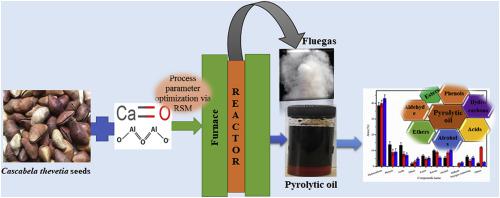Journal of the Energy Institute ( IF 5.6 ) Pub Date : 2020-05-11 , DOI: 10.1016/j.joei.2020.04.019 Ranjeet Kumar Mishra , Abhishek Muraraka , Kaustubha Mohanty

|
The present study deals with the optimization of process parameters and thermocatalytic pyrolysis of Cascabela thevetia (CT) seeds in a semi-batch cylindrical-shaped reactor. Response surface methodology (RSM) was employed for the optimization of process variables, while commercial catalysts CaO and Al2O3 were used for catalytic pyrolysis. From results, it was concluded that 525 °C temperature, 75 °C min−1 heating rate, and 75 mL min−1 flow of nitrogen yielded maximum pyrolytic liquid (45.26 wt%) while with the attendance of catalysts at 20 wt% increased the yield of pyrolytic liquid (49.12 wt% and 46.87 wt% for CaO and Al2O3 respectively). Optimization outcomes displayed that linear and quadratic terms of utilized factors were more noteworthy while interaction effects between the factors were not significant. Further, characterization of pyrolytic oil established that utilization of catalysts expressively enhanced its properties by reducing viscosity and boosted the calorific value. FTIR examination of pyrolytic oil showed that the attendance of phenols, ethers, alcohols, ketones, alkanes, acids, etc., while 1H NMR results supported the FTIR results. GC-MS analysis showed a substantial reduction of phenols and oxygen-rich products and boost the development of alcohol and aldehydes in pyrolytic oil with the introduction of catalysts. These parameters indicate improved properties of pyrolytic oil, which intensified its bioenergy capabilities.
中文翻译:

利用低成本催化剂优化Cascabela thevetia种子的工艺参数和催化热解以生产可再生燃料
本研究涉及半批量圆柱反应器中Cascabela thevetia(CT)种子的工艺参数优化和热催化热解。响应表面方法(RSM)用于优化工艺变量,而商用催化剂CaO和Al 2 O 3用于催化热解。从结果得出的结论是,在525°C的温度,75°C min -1的加热速率和75 mL min -1的氮气流下产生的最大热解液(45.26 wt%),而催化剂的加入量增加20 wt%热解液的产率(CaO和Al 2 O 3为49.12 wt%和46.87 wt%分别)。优化结果表明,利用因素的线性和二次项更值得注意,而因素之间的相互作用影响不显着。此外,热解油的表征证实了催化剂的利用通过降低粘度并提高了发热量而表达性地增强了其性能。FTIR对热解油的检查表明,苯酚,醚,醇,酮,烷烃,酸等的存在,而11 H NMR结果支持FTIR结果。GC-MS分析表明,通过引入催化剂,苯酚和富氧产物大量减少,并促进了热解油中醇和醛的发展。这些参数表明热解油的性能得到改善,从而增强了其生物能能力。









































 京公网安备 11010802027423号
京公网安备 11010802027423号